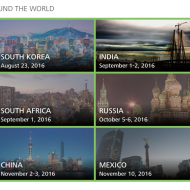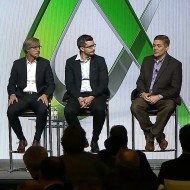The AU Leadership Forum (AULF), a conference within a conference, is off to a great start, beginning with last night’s networking reception. Designed for C-level executives, AULF attendees are already having many beneficial conversations with others that move beyond the introductory level. One attendee said he had an hour-long conversation with an architect last night where they started talking in detail about how to collaborate on projects.
Today’s keynote, featuring Autodesk VPs Callan Carpenter, Jon Pittman, and Phil Bernstein focused on the tectonic shifts that are taking place in business as a result of evolving technology. Callan Carpenter, who opened the session, described how technology is still important, but only to the degree that it is used to solve business problems. This trend is affecting all of us, no matter what our business.
Last year Autodesk announced a major shift in the way it does business—moving to the cloud, mobile, and social. The underlying trend and the driving forces behind this decision are tectonic transformations, where over time:
- Products are becoming services.
- Transactions are becoming relationships.
- Functions are becoming experiences.
Many of these trends are manifesting first in the consumer realm before they reach the business realm. Here are some examples presented by Jon Pittman and Phil Bernstein:
Trend #1: Moving from Products to Services
The Millennial generation, especially urban residents, no longer think in terms of owning a car, which most of us use only about 3-5% of the time anyway. They are moving from owning and using products to using services.
On the consumer side, we’re learning to match resources to needs much better than before. Car services such as zipcar.com or uber.com match consumption to need. Get the car for when you need it—no storage, no insurance, no obsolescence to worry about. Companies such as Spotify for music and Netflix for movies have changed the model from purchasing a product to using a service. Rent the Runway makes high-end fashions more accessible and almost as easy as renting a movie from Netflix. STEAM is a completely virtualized gaming environment where you get into a relationship with a gaming company that is continuous.
On the business side, Rolls Royce now rents jet engines by the hour. They own and maintain the engine, deal with the insurance, and so on. McKinstry, which started life as a mechanical, electrical, and plumbing subcontractor now designs, manufactures, and installs the entire building environment. They connect everything in a building to a digital sensory network and set up a contract for long-term system maintenance. Autodesk now offers software on demand, such as Autodesk® Simulation 360.
Trend #2: Moving from Transactions to Relationships
Under the old model, book sellers, such as Waldenbooks, focused on making transactions. That model has mostly gone away. Today’s model is more about building relationships based on trust, where the company is more like someone who knows you. For example, when you do business with Amazon.com, the company keeps track of what you order for yourself or as gifts, makes recommendations, and stores your payment information. It’s the ethos of Amazon, according to John Pittman, that makes it work. Decisions at Amazon are made in favor of the customer. Also on the consumer side, Garmin Connect keeps track of your running history, and lets you connect (and compete) with other runners.
On the business side, through a Strategic Innovation Partnership between Nike and Autodesk, the two companies are working together to envision the future and to co-create it. Autodesk is learning how Nike views manufacturing and human performance.
Trend #3: Moving from Function to Experience
In the past, differentiating your company on function was the most important goal. The primary function was often around “saving the customer money.” McDonald has successfully used the functional approach: cheap food prepared quickly and efficiently on a massive scale. In contrast, the restaurant Tao provides an Asian-themed dining experience, where food and service are designed to tap into the image of who you are and what your aspirations are.
At Walmart, a master of the functional approach, you can buy Nike products at a good price. But people still go to the Nike stores for the experience. The same goes for Apple stores—selling an experience has been immensely profitable for them.
Manufacturing has traditionally been about making objects. But Lexus has changed the way people think about a car company, working to get people into a continuous relationship with service facilities that create an experience for the consumer and thereby create brand loyalty.
Service, relationship, experience…these are the megatrends that are shaping industry today and in the near future.
–sandy



